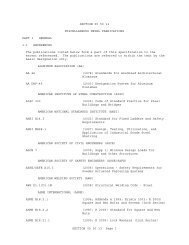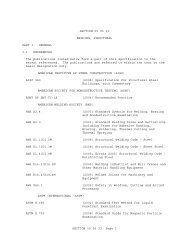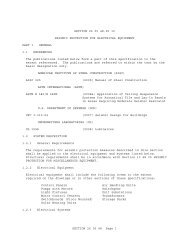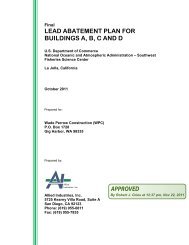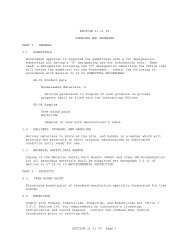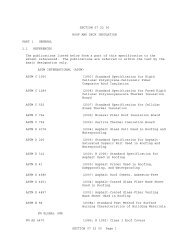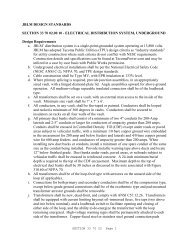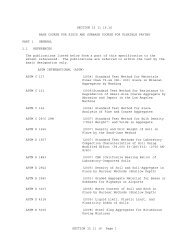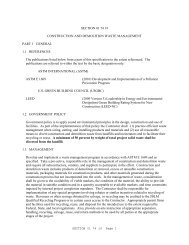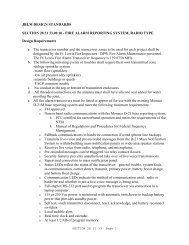33 11 00 Water Distribution.pdf - WPC
33 11 00 Water Distribution.pdf - WPC
33 11 00 Water Distribution.pdf - WPC
Create successful ePaper yourself
Turn your PDF publications into a flip-book with our unique Google optimized e-Paper software.
a suitable valve box, means for manual operation, and an adjacent pipe joint<br />
to facilitate valve removal. Valve operators shall restrict closing to a<br />
rate requiring approximately 60 seconds, from fully open to fully closed.<br />
2.1.2.5 Pressure Reducing Valves<br />
Pressure reducing valves shall maintain a constant downstream pressure<br />
regardless of fluctuations in demand. The valves shall be of the<br />
hydraulically-operated, pilot controlled, globe or angle type, and may be<br />
actuated either by diaphragm or piston. The pilot control shall be the<br />
diaphragm-operated, adjustable, spring-loaded type, designed to permit flow<br />
when controlling pressure exceeds the spring setting. Ends shall be<br />
flanged. Valve bodies shall be bronze, cast iron or cast steel with bronze<br />
trim. Valve stem shall be stainless steel. Valve discs and diaphragms<br />
shall be synthetic rubber. Valve seats shall be bronze. Pilot controls<br />
shall be bronze with stainless steel working parts.<br />
2.1.2.6 Vacuum and Air Relief Valves<br />
Vacuum and air relief valves shall be of the size shown and shall be of a<br />
type that will release air and prevent the formation of a vacuum. The<br />
valves shall automatically release air when the lines are being filled with<br />
water and shall admit air into the line when water is being withdrawn in<br />
excess of the inflow. Valves shall be iron body with bronze trim and<br />
stainless steel float.<br />
2.1.2.7 Fire Hydrants<br />
Dry-barrel type. Paint hydrants with at least one coat of primer and two<br />
coats of enamel paint as discussed in subparagraph d. below. Stencil<br />
hydrant number and main size on the hydrant barrel using black stencil<br />
paint.<br />
a. Dry-Barrel Type Fire Hydrants: Dry-barrel type hydrants, AWWA C502<br />
or UL 246, "Base Valve" design, shall have 6 inch inlet, 5 1/4 inch<br />
valve opening, one 4 1/2 inch pumper connection, and two 2 1/2<br />
inch hose connections. Inlet shall have mechanical-joint end only,<br />
except where flanged end is indicated; end shall conform to the<br />
applicable requirements as specified for the joint. Size and shape<br />
of operating nut, cap nuts, and threads on hose and pumper<br />
connections shall be as specified in AWWA C502. Hydrants indicated<br />
as "traffic type," shall have frangible sections as mentioned in<br />
AWWA C502. The traffic type hydrant shall have special couplings<br />
joining upper and lower sections of hydrant barrel and upper and<br />
lower sections of hydrant stem and shall be designed to have the<br />
special couplings break from a force not less than that which would<br />
be imposed by a moving vehicle; hydrant shall operate properly<br />
under normal conditions. Hydrants shall have a 5-inch non-threaded<br />
adapter to the 4-1/2 inch pumper connection and a lock to keep the<br />
connection from becoming unintentionally disengaged.<br />
b. Classification of Hydrants: Hydrants shall be classified in<br />
accordance with their rated capacities based on flow tests to be<br />
conducted by the contractor as follows:<br />
(1) Class AA - Rated capacity of 15<strong>00</strong> gpm (5680 L/min) or greater<br />
SECTION <strong>33</strong> <strong>11</strong> <strong>00</strong> Page 16



